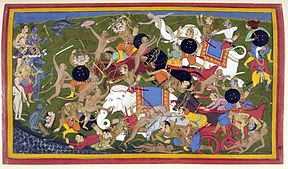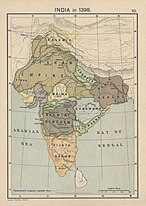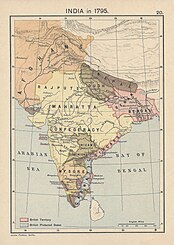India
Republic of India Bhārat Gaṇarājya (see other local names) | |
|---|---|
 Flag  State emblem | |
Motto: "Satyameva Jayate" (Sanskrit) "Truth Alone Triumphs" | |
Anthem: "Jana Gana Mana "Thou Art the Ruler of the Minds of All People" | |
National song "Vande Mataram" (Sanskrit) "I Bow to Thee, Mother" | |
 Area controlled by India shown in dark green; regions claimed but not controlled shown in light green Area controlled by India shown in dark green; regions claimed but not controlled shown in light green | |
| Capital | New Delhi 28°36′50″N 77°12′30″E |
| Largest city |
|
| Official languages |
|
| Recognised national languages | None |
| Recognised regional languages | show State level and Eighth Schedule[ |
| Native languages | 447 languages |
| Religion (2011) |
|
| Demonym(s) | Indian |
| Membership |
|
| Government | Federal parliamentary constitutional republic |
• President | Ram Nath Kovind |
• Vice President | Venkaiah Naidu |
• Prime Minister | Narendra Modi |
• Chief Justice | N. V. Ramana |
• Lok Sabha Speaker | Om Birla |
| Legislature | Parliament |
• Upper house | Rajya Sabha |
• Lower house | Lok Sabha |
| Independence from the United Kingdom | |
• Dominion | 15 August 1947 |
• Republic | 26 January 1950 |
| Area | |
• Total | 3,287,263 km2 (1,269,219 sq mi) (7th) |
• Water (%) | 9.6 |
| Population | |
• 2018 estimate | |
• 2011 census | 1,210,854,977 (2nd) |
• Density | 411.8/km2 (1,066.6/sq mi) (19th) |
| GDP (PPP) | 2021 estimate |
• Total | |
• Per capita | |
| GDP (nominal) | 2021 estimate |
• Total | |
• Per capita | |
| Gini (2011) | 35.7 medium · 98th |
| HDI (2019) | medium · 131st |
| Currency | Indian rupee (₹) (INR) |
| Time zone | UTC+05:30 (IST) |
| DST is not observed | |
| Date format |
|
| Mains electricity | 230 V–50 Hz |
| Driving side | left |
| Calling code | +91 |
| ISO 3166 code | IN |
| Internet TLD | .in (others) |
India, officially the Republic of India (Hindi: Bhārat Gaṇarājya), is a country in South Asia. It is the second-most populous country, the seventh-largest country by land area, and the most populous democracy in the world. Bounded by the Indian Ocean on the south, the Arabian Sea on the southwest, and the Bay of Bengal on the southeast, it shares land borders with Pakistan to the west; China, Nepal, and Bhutan to the north; and Bangladesh and Myanmar to the east. In the Indian Ocean, India is in the vicinity of Sri Lanka and the Maldives; its Andaman and Nicobar Islands share a maritime border with Thailand, Myanmar and Indonesia.
Modern humans arrived on the Indian subcontinent from Africa no later than 55,000 years ago.Their long occupation, initially in varying forms of isolation as hunter-gatherers, has made the region highly diverse, second only to Africa in human genetic diversity. Settled life emerged on the subcontinent in the western margins of the Indus river basin 9,000 years ago, evolving gradually into the Indus Valley Civilisation of the third millennium BCE.By 1200 BCE, an archaic form of Sanskrit, an Indo-European language, had diffused into India from the northwest, unfolding as the language of the Rigveda, and recording the dawning of Hinduism in India. The Dravidian languages of India were supplanted in the northern and western regions By 400 BCE, stratification and exclusion by caste had emerged within Hinduism, and Buddhism and Jainism had arisen, proclaiming social orders unlinked to heredity. Early political consolidations gave rise to the loose-knit Maurya and Gupta Empires based in the Ganges Basin. Their collective era was suffused with wide-ranging creativity, but also marked by the declining status of women, and the incorporation of untouchability into an organised system of belief. In South India, the Middle kingdoms exported Dravidian-languages scripts and religious cultures to the kingdoms of Southeast Asia.
In the early medieval era, Christianity, Islam, Judaism, and Zoroastrianism put down roots on India's southern and western coasts. Muslim armies from Central Asia intermittently overran India's northern plains, eventually establishing the Delhi Sultanate, and drawing northern India into the cosmopolitan networks of medieval Islam. In the 15th century, the Vijayanagara Empire created a long-lasting composite Hindu culture in south India. In the Punjab, Sikhism emerged, rejecting institutionalised religion. The Mughal Empire, in 1526, ushered in two centuries of relative peace, leaving a legacy of luminous architecture. Gradually expanding rule of the British East India Company followed, turning India into a colonial economy, but also consolidating its sovereignty. British Crown rule began in 1858. The rights promised to Indians were granted slowly, but technological changes were introduced, and ideas of education, modernity and the public life took root. A pioneering and influential nationalist movement emerged, which was noted for nonviolent resistance and became the major factor in ending British rule. In 1947 the British Indian Empire was partitioned into two independent dominions, a Hindu-majority Dominion of India and a Muslim-majority Dominion of Pakistan, amid large-scale loss of life and an unprecedented migration.
India has been a federal republic since 1950, governed in a democratic parliamentary system. It is a pluralistic, multilingual and multi-ethnic society. India's population grew from 361 million in 1951 to 1.211 billion in 2011. During the same time, its nominal per capita income increased from US$64 annually to US$1,498, and its literacy rate from 16.6% to 74%. From being a comparatively destitute country in 1951,India has become a fast-growing major economy and a hub for information technology services, with an expanding middle class. It has a space programme which includes several planned or completed extraterrestrial missions. Indian movies, music, and spiritual teachings play an increasing role in global culture. India has substantially reduced its rate of poverty, though at the cost of increasing economic inequality. India is a nuclear-weapon state, which ranks high in military expenditure. It has disputes over Kashmir with its neighbours, Pakistan and China, unresolved since the mid-20th century. Among the socio-economic challenges India faces are gender inequality, child malnutrition, and rising levels of air pollution.India's land is megadiverse, with four biodiversity hotspots.Its forest cover comprises 21.7% of its area.India's wildlife, which has traditionally been viewed with tolerance in India's culture, is supported among these forests, and elsewhere, in protected habitats.
9 interesting facts about India's people
With a population of nearly 1.4 billion, India's people are as diverse as its landscape and history.
1. India's only female prime minister was assassinated
Indira Gandhi was India's first and only female prime minister. She was the daughter of Jawaharlal Nehru – India's first prime minister– not the child of leader Mahatma Gandhi as her surname might suggest. She served from 1966-1977 and was re-elected in 1980 before being assassinated in 1984 while still in office.
2. Mother Teresa's sari is still symbolic
Mother Teresa first donned her famous sari in 1948; it's now the uniform for nuns in her order, the Missionaries of Charity. Born in Macedonia in 1910, Mother Teresa – also known as Saint Teresa of Calcutta – was a Roman Catholic nun and missionary. She devoted her life to helping the poor in the city of although her methods were considered controversial by some.
3. Indian weddings are a colourful occasion
A woman may be forbidden from housework while any colour from the bridal mendhi (henna) is on her hands. Indian weddings are often colourful extended occasions that can last for anything from 3 days to a full week. The ceremonies start with the Ganesh pooja, Usually, a private ceremony that takes place with the couple and their close families to honour good fortune, followed by the mendhi ceremony the next day where henna patterns are painted on the bride and her female friends and family. That evening, there's often the sangeet- a musical night to welcome all the wedding guests, with the main ceremony and reception happening on the third day.

4. The country is third in the world for billionaires
India now boasts 6,884 ultra-high-net-worth individuals with assets over US $30 million and claims to have 140 billionaires- ranking the country third in the world for billionaires, behind the USA and China.
5. The majority of the population is Hindu
Nearly 80 percent of India's population are Hindu, 15 percent are Muslim and millions more are Sikh, Jain or Christian.
6. Not just one national language
In India, there isn’t one national language- the constitution states there are 23 official languages. While Hindi is the most widely spoken and the language of the central government in India, no language is more official than the others. According to the constitution, each of the 22 local languages (plus English) are of equal importance.
7. The sari is over 5000 years old
The sari dates back to at least 3000 BCE. Sari wearers often choose the colour of their garment based on the occasion. Red is often worn by brides to symbolise fertility and prosperity.

8. Improvement in literacy
India has an adult literacy rate of nearly 75 percent. While the country has made significant improvements over the years, it has yet to meet the worldwide average literacy rate of 86.5 percent.
9. The origins of chess
It is claimed that the game of chess originated in India some 1,500 years ago. It is said to be based on the 7th-century war game called chaturanga that flourished in northwestern India at the time.

7 impressive economic facts about India
Emerging as one of the fastest growing major economies in the world, India is expected to be one of the top 3 economic powers in 10-15 years.
1. India is the third-largest economy
In terms of purchasing power (comparing economic productivity and standards of living), India is the world's third-largest economy.
2. Closed currency restrictions
The Indian rupee is a closed currency- there are harsh restrictions on bringing the currency in and out of the country. Visitors must arrive with cash and exchange their money at the airport or bank currency booth, or use an ATM to withdraw rupees once in the country.
3. Bollywood shines on the world stage
Bollywood is the world's largest producer of films, surpassing Nollywood (Nigerian Cinema) and even Hollywood. On average, Bollywood produces between 1,500-2,000 feature films a year.
Are you curious to know more about the inner workings of the Bollywood industry? Head to Mumbai to partake

4. The powerhouse of Indian Railways
Indian Railways is one of the top employers on the planet. With a staggering 1.4 million employees, India's state-owned railway network operates a huge, extensive network that extends across the country for hundreds of thousands of miles. Each day roughly 23 million passengers are transported on this extensive network.

5. Newspapers to millions
India is the second-largest market of newspapers in the world- over 100,000 publications and 1300 million readers.
6. Outsourcing experts
Roughly 67 percent of the world’s outsourcing is done in India. The Indian IT industry is valued at US 150- billion.
7. Nalanda International University is one of the world's most ancient
In rural Bihar, Nalanda, one of the world's most ancient universities is being rebuilt. It was first established as a centre of learning in the 5th century CE when a large Buddhist monastery stood on site. The new Nalanda International University is set to be completed in 2021/22- offering post-graduate courses on a wide variety of subjects.
The university is located in the rural area of Bihar, we recommend while you explore history.

6 fun facts about India's food/beverage scene
India's cuisine made of local spices, herbs, vegetables and fruits has influenced other cuisines from around the world- from Europe to the Caribbean.
1. Oldest cuisine in human history
Indian cuisine may be the oldest continuously prepared cuisine in known human history. Of course, what we know at home as "Indian food" varies widely from place to place in the country itself. From the Portuguese-inspired dishes of Goa to the tandoori ovens of the Punjab, there's a wealth of different dishes to discover on a trip to the country.

2. Dabbawallahs deliver a staggering amount of lunches
Normally, Mumbai's foodservice network known as dabbawallahs delivers over 200,000 lunch boxes by bike and train from home to office daily. Unfortunately, the pandemic has drastically impacted their services- with many students and workers staying at home. In an intricate system, each person receives the correct tiffin box filled with hot food prepared by their family, and in the afternoon the empty boxes are picked up and returned home again. There's even a movie based on the phenomenon, 2013's The Lunchbox.
and taste a dabbawallah lunch for yourself.
3. Tea dating back to 750 BCE
Tea had been growing in India for centuries before the British began its commercial cultivation. The first recorded mention of tea in the country dates back to 750 BCE, and it was reportedly also consumed as a vegetable dish, fried in oil with garlic. When the British arrived in the 18th century, they began growing tea on a commercial scale to reduce their reliance on buying tea from China.

4. Alcohol is banned in some states
Alcohol consumption is banned in five Indian states; the drinking age varies from 18 to 30 in the others. If you're travelling to Gujarat, Bihar, Nagaland or the Union Territory of Lakshadweep know that you won’t be able to buy alcohol. In addition, many states practice "dry days" on major religious holidays, when it's forbidden to sell alcohol.
5. Britain's favourite dish has Indian roots
Chicken tikka masala has become one of Britain’s national dishes- some say it has overtaken Fish and Chips. Although there are discrepancies about how this favoured curry came to be in the UK- whether it was created in the ’70s by a Bangladeshi chef in Glasgow or simply inspired by butter chicken- the tikka part of the dish originated some 5,000 years ago in India.

6. Asia's largest wholesale spice market
Khari Baoli in Delhi is Asia's largest wholesale spice market. It's been in operation since the 17th century and is named after the street on which it's situated.
Wondering how to tackle the largest spice market in Asia? There's no need to be overwhelmed- you can always to navigate the labyrinth with you.

History
Ancient India
By 55,000 years ago, the first modern humans, or Homo sapiens, had arrived on the Indian subcontinent from Africa, where they had earlier evolved. The earliest known modern human remains in South Asia date to about 30,000 years ago. After 6500 BCE, evidence for domestication of food crops and animals, construction of permanent structures, and storage of agricultural surplus appeared in Mehrgarh and other sites in what is now Balochistan, Pakistan. These gradually developed into the Indus Valley Civilisation, the first urban culture in South Asia, which flourished during 2500–1900 BCE in what is now Pakistan and western India.Centred around cities such as Mohenjo-daro, Harappa, Dholavira, and Kalibangan, and relying on varied forms of subsistence, the civilisation engaged robustly in crafts production and wide-ranging trade.
During the period 2000–500 BCE, many regions of the subcontinent transitioned from the Chalcolithic cultures to the Iron Age ones. The Vedas, the oldest scriptures associated with Hinduism,were composed during this period,[82] and historians have analysed these to posit a Vedic culture in the Punjab region and the upper Gangetic Plain. Most historians also consider this period to have encompassed several waves of Indo-Aryan migration into the subcontinent from the north-west. The caste system, which created a hierarchy of priests, warriors, and free peasants, but which excluded indigenous peoples by labelling their occupations impure, arose during this period. On the Deccan Plateau, archaeological evidence from this period suggests the existence of a chiefdom stage of political organisation. In South India, a progression to sedentary life is indicated by the large number of megalithic monuments dating from this period, as well as by nearby traces of agriculture, irrigation tanks, and craft traditions.[84]
In the late Vedic period, around the 6th century BCE, the small states and chiefdoms of the Ganges Plain and the north-western regions had consolidated into 16 major oligarchies and monarchies that were known as the mahajanapadas. The emerging urbanisation gave rise to non-Vedic religious movements, two of which became independent religions. Jainism came into prominence during the life of its exemplar, Mahavira. Buddhism, based on the teachings of Gautama Buddha, attracted followers from all social classes excepting the middle class; chronicling the life of the Buddha was central to the beginnings of recorded history in India. In an age of increasing urban wealth, both religions held up renunciation as an ideal,and both established long-lasting monastic traditions. Politically, by the 3rd century BCE, the kingdom of Magadha had annexed or reduced other states to emerge as the Mauryan Empire.The empire was once thought to have controlled most of the subcontinent except the far south, but its core regions are now thought to have been separated by large autonomous areas. The Mauryan kings are known as much for their empire-building and determined management of public life as for Ashoka's renunciation of militarism and far-flung advocacy of the Buddhist dhamma.
The Sangam literature of the Tamil language reveals that, between 200 BCE and 200 CE, the southern peninsula was ruled by the Cheras, the Cholas, and the Pandyas, dynasties that traded extensively with the Roman Empire and with West and South-East Asia. In North India, Hinduism asserted patriarchal control within the family, leading to increased subordination of women. By the 4th and 5th centuries, the Gupta Empire had created a complex system of administration and taxation in the greater Ganges Plain; this system became a model for later Indian kingdoms. Under the Guptas, a renewed Hinduism based on devotion, rather than the management of ritual, began to assert itself. This renewal was reflected in a flowering of sculpture and architecture, which found patrons among an urban elite. Classical Sanskrit literature flowered as well, and Indian science, astronomy, medicine, and mathematics made significant advances.
Medieval India
The Indian early medieval age, from 600 to 1200 CE, is defined by regional kingdoms and cultural diversity. When Harsha of Kannauj, who ruled much of the Indo-Gangetic Plain from 606 to 647 CE, attempted to expand southwards, he was defeated by the Chalukya ruler of the Deccan.[104] When his successor attempted to expand eastwards, he was defeated by the Pala king of Bengal. When the Chalukyas attempted to expand southwards, they were defeated by the Pallavas from farther south, who in turn were opposed by the Pandyas and the Cholas from still farther south. No ruler of this period was able to create an empire and consistently control lands much beyond their core region. During this time, pastoral peoples, whose land had been cleared to make way for the growing agricultural economy, were accommodated within caste society, as were new non-traditional ruling classes.The caste system consequently began to show regional differences.
In the 6th and 7th centuries, the first devotional hymns were created in the Tamil language. They were imitated all over India and led to both the resurgence of Hinduism and the development of all modern languages of the subcontinent. Indian royalty, big and small, and the temples they patronised drew citizens in great numbers to the capital cities, which became economic hubs as well. Temple towns of various sizes began to appear everywhere as India underwent another urbanisation. By the 8th and 9th centuries, the effects were felt in South-East Asia, as South Indian culture and political systems were exported to lands that became part of modern-day Myanmar, Thailand, Laos, Cambodia, Vietnam, Philippines, Malaysia, and Java. Indian merchants, scholars, and sometimes armies were involved in this transmission; South-East Asians took the initiative as well, with many sojourning in Indian seminaries and translating Buddhist and Hindu texts into their languages.
After the 10th century, Muslim Central Asian nomadic clans, using swift-horse cavalry and raising vast armies united by ethnicity and religion, repeatedly overran South Asia's north-western plains, leading eventually to the establishment of the Islamic Delhi Sultanate in 1206. The sultanate was to control much of North India and to make many forays into South India. Although at first disruptive for the Indian elites, the sultanate largely left its vast non-Muslim subject population to its own laws and customs.By repeatedly repulsing Mongol raiders in the 13th century, the sultanate saved India from the devastation visited on West and Central Asia, setting the scene for centuries of migration of fleeing soldiers, learned men, mystics, traders, artists, and artisans from that region into the subcontinent, thereby creating a syncretic Indo-Islamic culture in the north. The sultanate's raiding and weakening of the regional kingdoms of South India paved the way for the indigenous Vijayanagara Empire. Embracing a strong Shaivite tradition and building upon the military technology of the sultanate, the empire came to control much of peninsular India,and was to influence South Indian society for long afterwards.
Early modern India
In the early 16th century, northern India, then under mainly Muslim rulers, fell again to the superior mobility and firepower of a new generation of Central Asian warriors. The resulting Mughal Empire did not stamp out the local societies it came to rule. Instead, it balanced and pacified them through new administrative practices and diverse and inclusive ruling elites, leading to more systematic, centralised, and uniform rule. Eschewing tribal bonds and Islamic identity, especially under , the Mughals united their far-flung realms through loyalty, expressed through a Persianised culture, to an emperor who had near-divine status. The Mughal state's economic policies, deriving most revenues from agriculture and mandating that taxes be paid in the well-regulated silver currency, caused peasants and artisans to enter larger markets.The relative peace maintained by the empire during much of the 17th century was a factor in India's economic expansion, resulting in greater patronage of , literary forms, textiles, and architecture. Newly coherent social groups in northern and western India, such as the Marathas, the Rajputs, and the Sikhs, gained military and governing ambitions during Mughal rule, which, through collaboration or adversity, gave them both recognition and military experience.Expanding commerce during Mughal rule gave rise to new Indian commercial and political elites along the coasts of southern and eastern India.As the empire disintegrated, many among these elites were able to seek and control their own affairs.
By the early 18th century, with the lines between commercial and political dominance being increasingly blurred, a number of European trading companies, including the English East India Company, had established coastal outposts.The East India Company's control of the seas, greater resources, and more advanced military training and technology led it to increasingly assert its military strength and caused it to become attractive to a portion of the Indian elite; these factors were crucial in allowing the company to gain control over the Bengal region by 1765 and sideline the other European companies.Its further access to the riches of Bengal and the subsequent increased strength and size of its army enabled it to annexe or subdue most of India by the 1820s.[132] India was then no longer exporting manufactured goods as it long had, but was instead supplying the British Empire with raw materials. Many historians consider this to be the onset of India's colonial period. By this time, with its economic power severely curtailed by the British parliament and having effectively been made an arm of British administration, the company began more consciously to enter non-economic arenas like education, social reform, and culture.
15 Top-Rated Tourist Attractions in India
1. The Taj Mahal, Agra
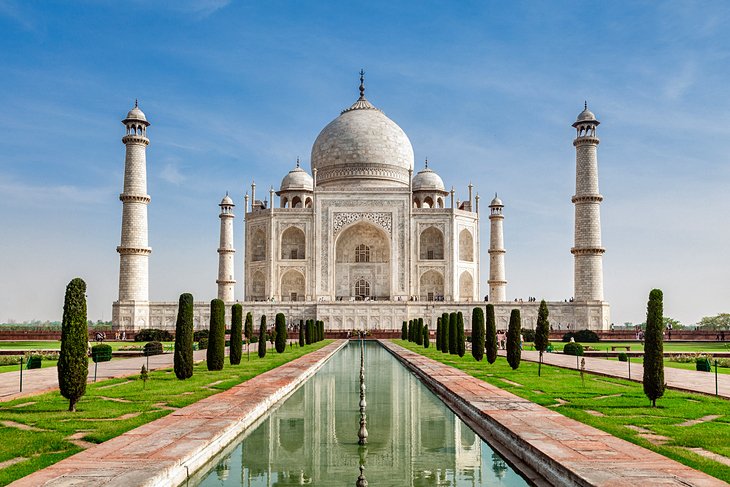
Perhaps India's most recognizable building, the Taj Mahal is also the world's most famous testimony to the power of love. Named after Mumtaz Mahal, the favorite wife of Emperor Shah Jahan, this most beautiful of mausoleums was begun upon her death in 1631 and took 20,000 workmen until 1648 to complete.
Incorporating many elements of Islamic design including arches, minarets, an onion-shaped dome, and black calligraphy inlaid around the entrance, the Taj Mahal is largely constructed of white marble decorated with delicate inlaid floral patterns and precious and semi-precious stones such as jade, lapis lazuli, diamonds, and mother of pearl.
The best time to visit is either at dawn or dusk when the atmosphere is brilliantly altered by the change in lighting. If possible, try to catch a view of the Taj Mahal's reflection from the far bank of the Yamuna River-it makes for a memorable (and safe) selfie.
Address: 64 Taj Road, Agra-282001
2. The Holy City of Varanasi
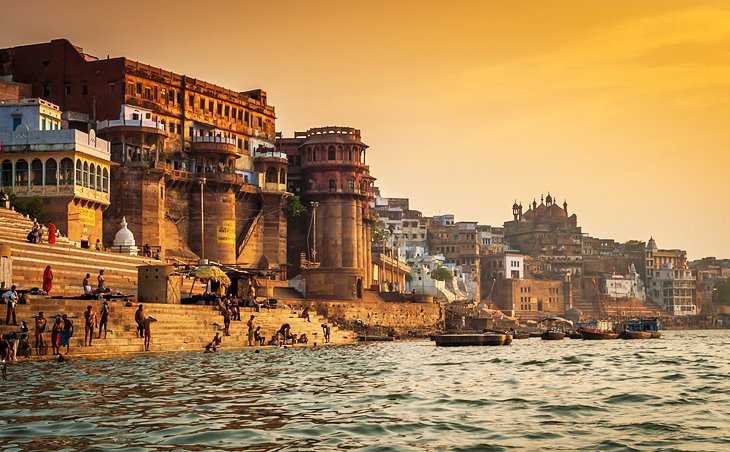
A major pilgrimage center for Hindus, the holy city of Varanasi has long been associated with the mighty Ganges River, one of the faith's most important religious symbols. Dating back to the 8th century BC, Varanasi is one of the oldest still inhabited cities in the world.
It offers many reasons to visit, not least of them the chance to explore the Old Quarter adjacent to the Ganges where you'll find the Kashi Vishwanath Temple, built in 1780 (the New Vishwanath Temple with its seven separate temples is also of interest).
Bathing in the Ganges is of great importance to Hindus, and numerous locations known as "ghats" feature stairways leading to the water where the faithful bathe before prayers.
All told, Varanasi boasts more than 100 ghats, the largest being Dasashvamedh Ghat and Assi Ghat (the latter, at the confluence of the Ganges and Asi rivers, is considered particularly holy). Also worth seeing is Banaras Hindu University, established in 1917 and noted for its massive library with more than a million books, and the superb Bharat Kala Bhavan museum featuring fine collections of miniature paintings, sculptures, palm-leaf manuscripts, and local history
3. Harmandir Sahib: The Golden Temple of Amritsar
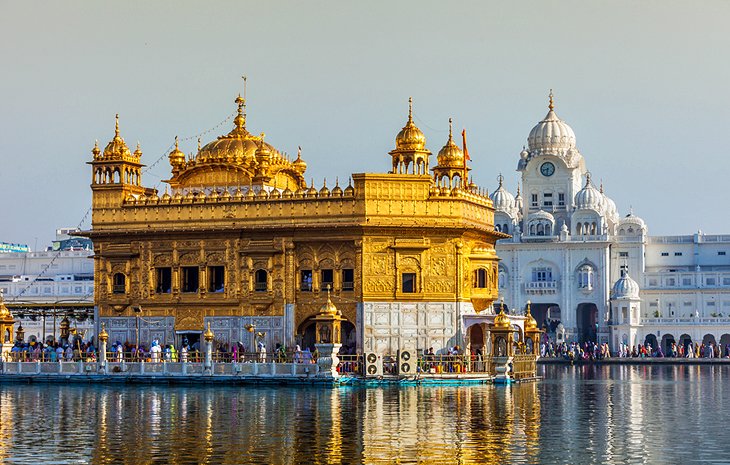
Founded in 1577 by Ram Das, Amritsar is an important hub of Sikh history and culture. The main attraction here is Harmandir Sahib, opened in 1604 and still often referred to as the Golden Temple for its beautiful gold decoration. The holiest of India's many Sikh shrines (it also attracts many Hindus and people of other faiths), the temple was built in a blend of Hindu and Islamic styles, its lower marble section featuring such flourishes as ornate inlaid floral and animal motifs, while the large golden dome represents a lotus flower, a symbol of purity to Sikhs.
In addition to its splendid design, visitors are equally impressed with the temple's spiritual atmosphere, an effect enhanced by the prayers continuously chanted from the Sikh holy book and broadcast throughout the complex. Part of the overall experience-and visitors are welcome to participate-is the chance to enjoy one of the 50,000 free meals the attraction serves up to visitors each and every day.
Address: Golden Temple Road, Amritsar, Punjab 143006
4. The Golden City: Jaisalmer
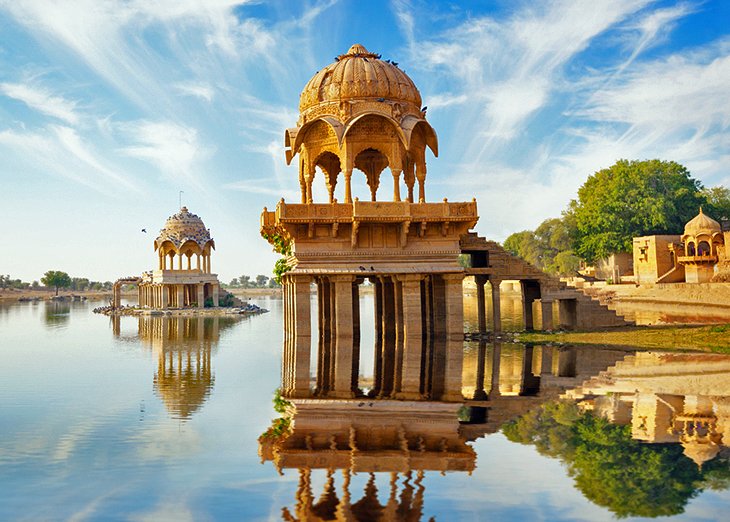
So named for the yellow sandstone used in most of its buildings, the Golden City of Jaisalmer is an oasis of splendid old architecture that rises from the sand dunes of the Thar Desert. Once a strategic outpost, today the city is filled with splendid old mansions, magnificent gateways, and the massive Jaisalmer Fort-also known as the Golden Fort-a daunting 12th-century structure that rises high above the town.
In addition to its palaces, temples, and fine old homes, the fortress boasts 99 bastions along with massive gates leading to its main courtyard where you'll find the seven-story-tall Maharaja's Palace. Started in the early 1500s and added to by successive rulers right up until the 19th century, the palace offers sections open to the public including areas beautifully decorated with tiles from Italy and China, and intricately carved stone doors, as well as a number of Jain temples dating from the 12th to 16th centuries, each decorated with fine marble and sandstone images, palm-leaf manuscripts, and brightly painted ceilings.
Be sure to also check out the well-preserved 1,000-year-old library, Gyan Bhandar, with its many 16th-century manuscripts and antiquitie
5. The Red Fort, New Delhi
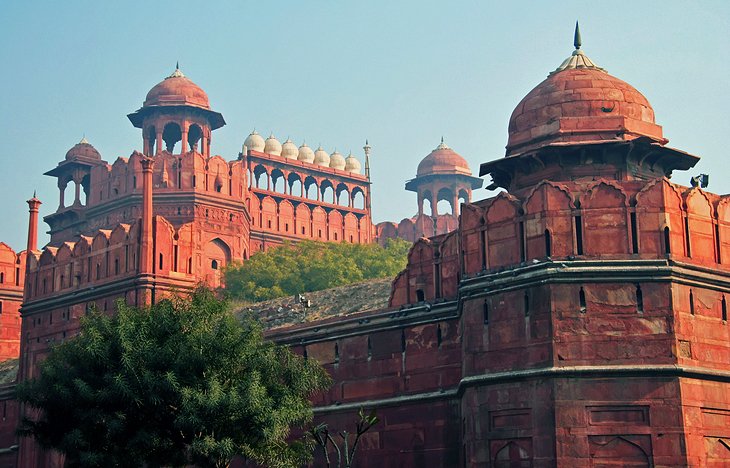
Built by Shah Jahan in 1648 as the seat of Mughal power-a role it maintained until 1857-the magnificent crescent-shaped Red Fort in New Delhi, named after the stunning red sandstone used in its construction, covers a vast area of more than two square kilometers, all of it surrounded by a large moat. Highlights include its two largest gates: the impressive Lahore Gate (the fort's main entrance) and the elaborately decorated Delhi Gate, once used by the emperor for ceremonial processions.
A fun part of a visit is exploring Chatta Chowk, a 17th-century covered bazaar selling everything from jewelry to silk garments, as well as souvenirs and food items. While you can explore the fort yourself, guided tours are offered and provide a fascinating insight into the life and times of the Shah, including a peek into the stunning white marble Hall of Public Audiences (Diwan-i-Am) where he received his subjects.
Hot Tip: Try to stick around for the sound and light show held each evening featuring important events in the fort's history.
Address: Netaji Subhash Marg, Chandni Chowk, New Delhi, Delhi 110000
6. Mumbai: The Gateway of India
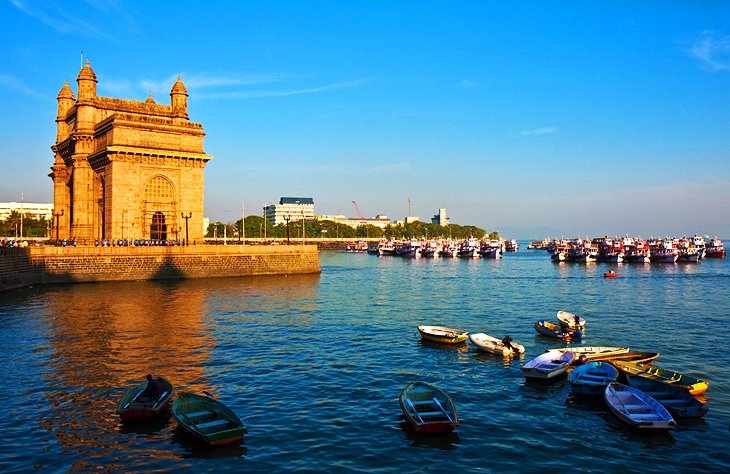
Standing an impressive 26 meters tall and overlooking the Arabian Sea, the iconic Gateway of India is a must-see when in Mumbai. Built to commemorate the arrival of King George V and his wife Queen Mary in 1911, this stunning piece of architecture was opened with much pomp and ceremony in 1924 and was, for a while, the tallest structure in the city.
Constructed entirely of yellow basalt and concrete and notable for its Indo-Saracenic design, the Gateway of India was also the scene of a rather less jubilant procession of British soldiers in 1948 when India gained its independence. These days, the huge archway provides a stunning backdrop that is as popular among locals as it is tourists. Hot Tip: After visiting the Gateway of India, pop over to the adjacent Taj Mahal
7. Mecca Masjid, Hyderabad
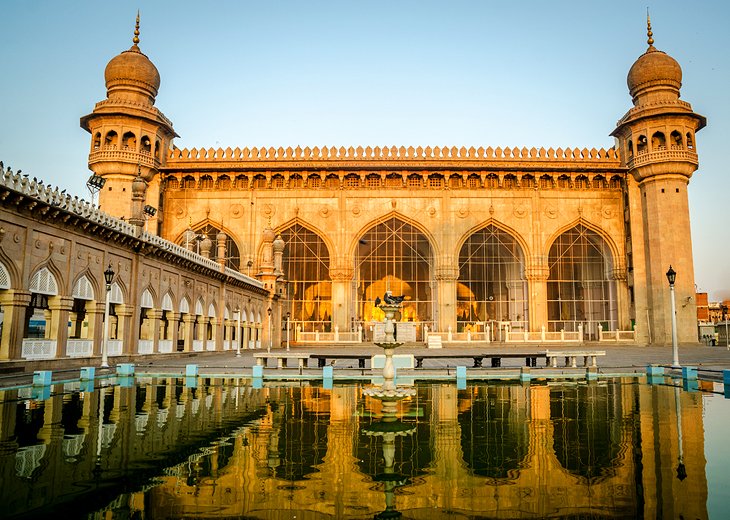
Construction of Hyderabad's Mecca Masjid, one of the world's largest mosques-and one of the oldest in India-began in 1614 during Mohammed Quli Qutub Shah's reign and took almost 80 years to complete. Large enough to accommodate 10,000 worshipers, this beautiful mosque's 15 enormous arches and pillars were each wrought from single slabs of black granite dragged to the site by huge cattle trains reputedly consisting of up to 1,400 bulls.
Taking its name from the bricks above the central gate that were brought here from Mecca, this impressive complex features highlights such as its main gateway, huge plaza, a large manmade pond, and a room that houses the hair of Prophet Mohammed. Other notable features include inscriptions from the Quran above many of the arches and doors, the exquisite roof of the main hall, the cornices around the entire mosque structure, and the floral motifs and friezes over the arches.
Address: Hyderabad, Telangana 500002
8. Amer Fort, Jaipur
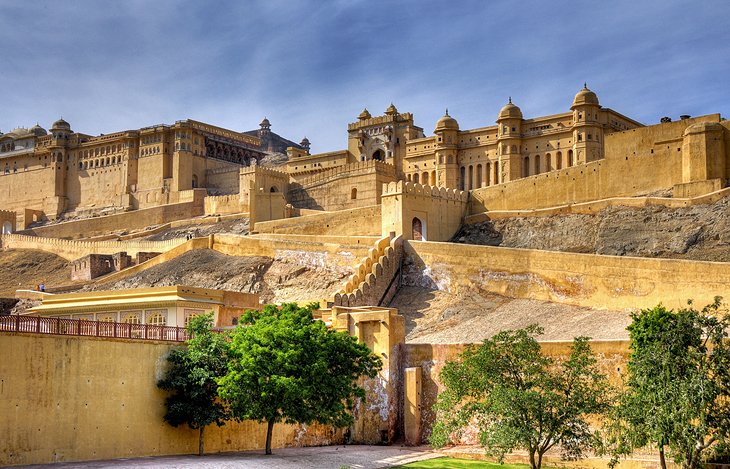
Amer Fort (often also spelt "Amber") was built as a fortified palace in 1592 by Maharaja Man Singh I and has long served as the capital of Jaipur. Carved high up into the hillside, the fort is accessible on foot via a steep climb or by shuttle rides from the town below (better still, let an elephant do the work). Highlights include Jaleb Chowk, the first courtyard, with its many decorated elephants, and the Shila Devi Temple, dedicated to the goddess of war. Also of note is the adjoining Hall of Public Audience (Diwan-i-Am) with its finely decorated walls and terraces frequented by monkeys.
Other highlights include Sukh Niwas (the Hall of Pleasure) with its many flowerbeds and a channel once used to carry cooling water, and the Temple of Victory (Jai Mandir), notable for its many decorative panels, colorful ceilings, and excellent views over the palace and the lake below.
Just above Amer Fort is Jaigarh Fort, built in 1726 by Jai Singh and featuring tall lookout towers, formidable walls, and the world's largest wheeled cannon. Be sure to also spend time wandering the walled Old City of Jaipur with its three fully restored gates and splendid bazaars, as well as the delightful City Palace, a massive complex of courtyards, gardens, and buildings.
9. The Beaches of Goa
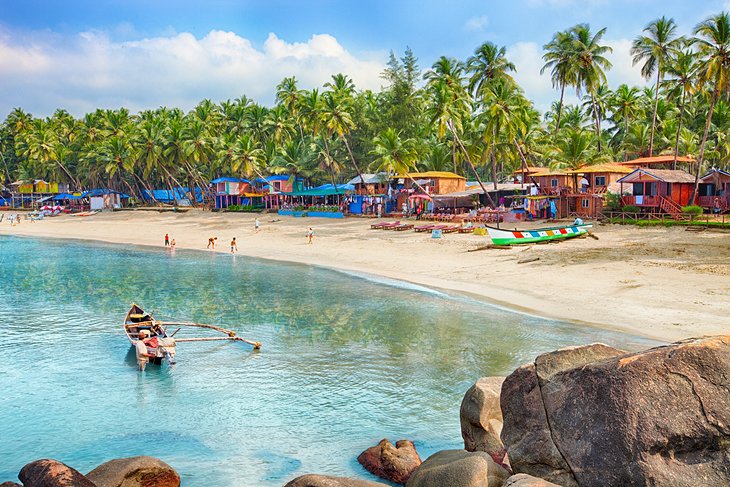
Long known within India as the "go-to" destination for those seeking a great beach holiday, Goa's beautiful western coastline, overlooking the Arabian Sea, has only recently been discovered by tourists from overseas.
Goa's more than 60 miles of coastline is home to some of the world's loveliest beaches, each with their own particular appeal. For those looking for peace and quiet, isolated Agonda Beach is a good choice, while Calangute Beach is by far the most commercial and crowded.
For those in search of posh resorts, yoga getaways, and spa vacations, the beaches of Mandrem, Morjim, and Ashwem are fashionable among wealthy Indians and Westerners alike. Palolem is another popular option in a beautiful setting.
While in Goa, be sure to visit the Bhagwan Mahavir Wildlife Sanctuary. This superb attraction is home to thick forests and plenty of fauna, including deer, monkeys, elephants, leopards, tigers, and black panthers-as well as India's famous king cobras-and some 200 species of birds.
Also worth a visit is Divar Island, accessed by ferry from Old Goa. Highlights include Piedade, a typical Goan village and home to the Church of Our Lady of Compassion with its interesting stucco work, Baroque plaster decorations, and altars, as well as stunning views of the surrounding countryside.
10. Periyar National Park and Wildlife Sanctuary, Madurai
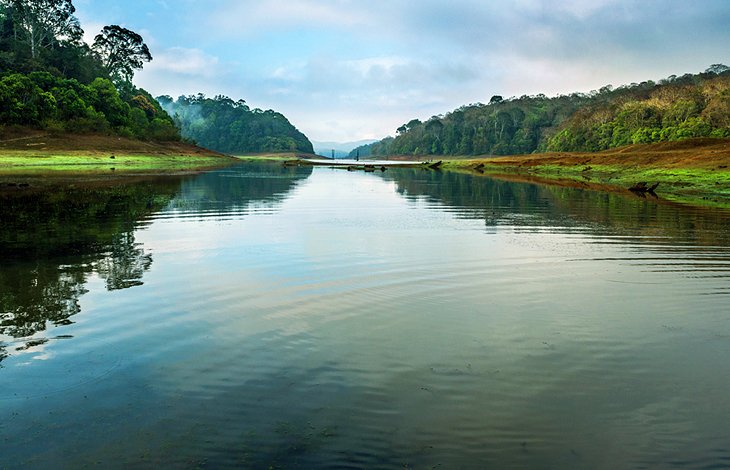
One of South India's most popular tourist attractions, Periyar National Park and Wildlife Sanctuary is centered around a lake built by British engineers in 1895 for irrigation and to provide water to the city of Madurai. Established in 1934, this beautiful park is home to numerous species of mammals, including a large free-roaming Indian elephant population, wild boar, otters, the lion-tailed macaque, and more than 20 Bengal tigers. Bird watching is a popular activity with frequent sightings of species such as darters, storks, kingfishers, hornbills, and racket-tailed drongos, along with many interesting varieties of butterflies.
The best ways to enjoy the park's splendid mountain scenery are to take a lake cruise or guided jungle walk, the latter allowing visitors a chance to come face to face with elephant herds and observe other wildlife from watchtowers and viewing platforms. Hot Tip: Be sure to stop at one of the many nearby spice, tea, or coffee plantations for a tour.
11. Agra Fort
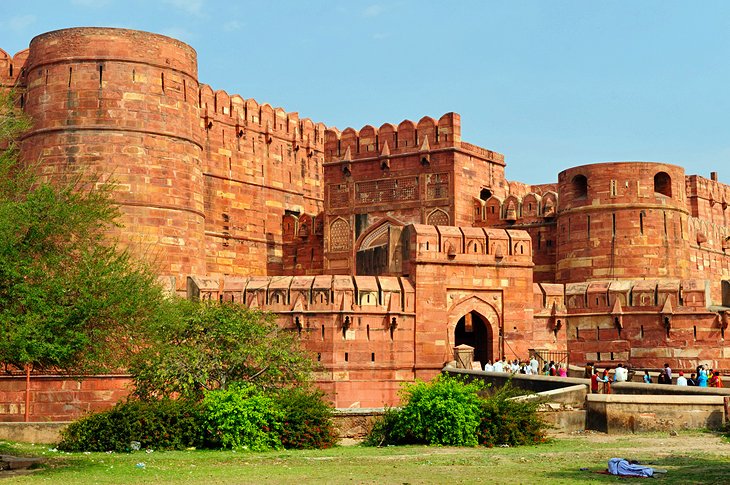 Agra Fort
Agra FortBuilt as a military structure in 1565 by Emperor Akbar with later additions by Shah Jahan, the stunning Agra Fort (also known as Agra's Red Fort) is an interesting mix of both Hindu and Muslim influences. Located a little more than two kilometers from the Taj Mahal, the fort is entered through Amar Singh Gate with its low outer wall and dogleg design built to confuse attackers. Once inside, you'll see two large interlinked sandstone buildings, Akbari Mahal and Jahangiri Mahal, the largest private residence in the complex.
Other highlights include the Khas Mahal (Private Palace), with its splendid copper roof, and the Anguri Bagh (Grape Garden), a jigsaw-patterned Mughal garden with numerous wonderful fountains and water channels as well as screens that once offered a private area for the emperor and his entourage. Also of note is the octagonal Musamman Burj tower, which later served as Shah Jahan's prison until his death.
Address: Rakabganj, Agra, Uttar Pradesh 282003
12. The Ellora Caves, Aurangabad
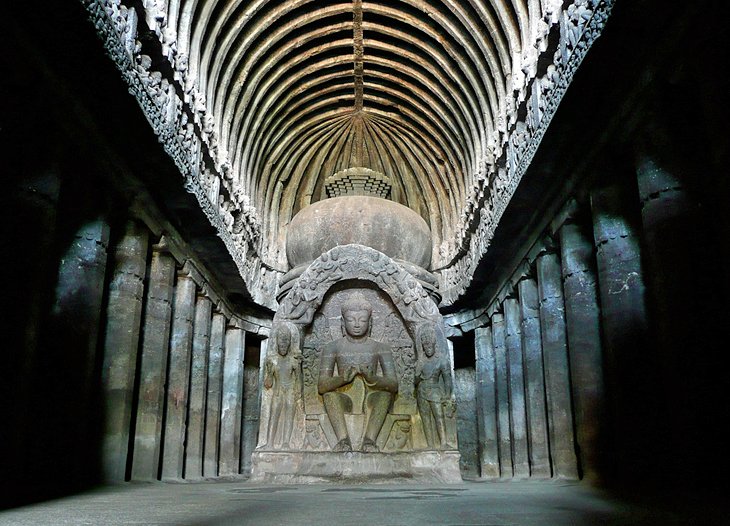
The famous monumental Ellora Caves were built between the 5th and 10th centuries by Buddhist, Jain, and Hindu monks, and make for an excellent excursion from Mumbai, some 300 kilometers to the west.
Now a UNESCO World Heritage Site, this remarkable collection of 34 carved monasteries, chapels, and temples-12 of them Buddhist, 17 Hindu, and five belonging to the Jain faith-were built in close proximity to each other, a reflection of the religious tolerance that existed during this period of Indian history.
Of the Buddhist monastery caves, highlights include a number of shrines featuring carvings of Buddha and saints dating from the 5th to 7th centuries, as well as the stunning Carpenter's Cave, considered one of the finest in India.
The Hindu caves are much more complex and were carved from the top down, so scaffolding was not necessary. Of these, the best is the Kailasa Temple, an enormous rock-cut temple representing Mount Kailasa and requiring the removal of 200,000 tons of rock.
13. Mehrangarh Fort, Jodhpur
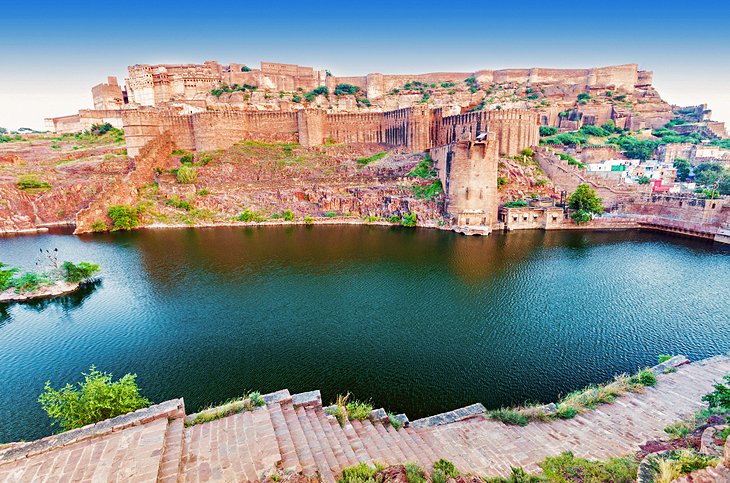
Dominating the old city of Jodhpur, the massive Mehrangarh Fort, one of the largest fortifications in India, was built in the 15th century to safeguard the people of the famous "Blue City," as Jodhpur is still known - a name derived from its indigo colored houses, painted blue to deflect the heat.
Built on top of a towering outcrop, Mehrangarh is an amazing feat of construction, its massive walls all but impenetrable. Access is via one of seven splendid gates, including Jaya Pol and Fateh Pol (the latter still bears scars from cannon attacks).
Highlights of a visit include exploring the fort's fascinating network of courtyards and palaces, as well as a museum housing a splendid collection of artifacts related to the Maharajas. Be sure to spend time in the historic center of Jodhpur itself, famous for its eight city gates, a lovely old clock tower, and numerous bazaars selling everything from vegetables to sweets, spices, and handicrafts.
Address: Fort Road, Jodhpur, Rajasthan 342006
14. Mysore Palace
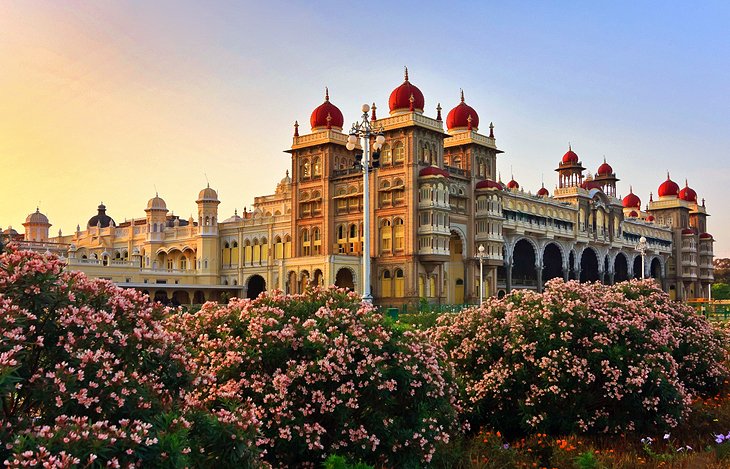
The sprawling city of Mysore is a delight to explore thanks to its eclectic mix of fine old colonial architecture; regal Indian palaces; and lush, well-manicured gardens. While those inclined towards shopping will enjoy spending time in the city's famous silk and sandalwood bazaars, the main attraction is magnificent Mysore Palace.
Completely rebuilt in 1897 after a devastating fire, this beautiful three-storied palace features highlights such as its elegant square towers and domes; the many ornate ceilings and pillars in Durbar Hall; and the splendid Marriage Pavilion, with its glazed floor tiles, stunning stained glass, artworks, and displays of jewelry (it's also where, on special occasions, the exquisite Golden Throne is exhibited).
For a real treat, be sure to catch one of the splendid light displays held each Sunday and during holidays, when the palace is illuminated by more than 90,000 lights. A fun way to explore the palace's massive grounds and gardens is as part of a cycle tour, available free once inside.
Address: Sayyaji Rao Road, Mysuru, Karnataka 570001
15. Mahabodhi Temple, Bodhgaya
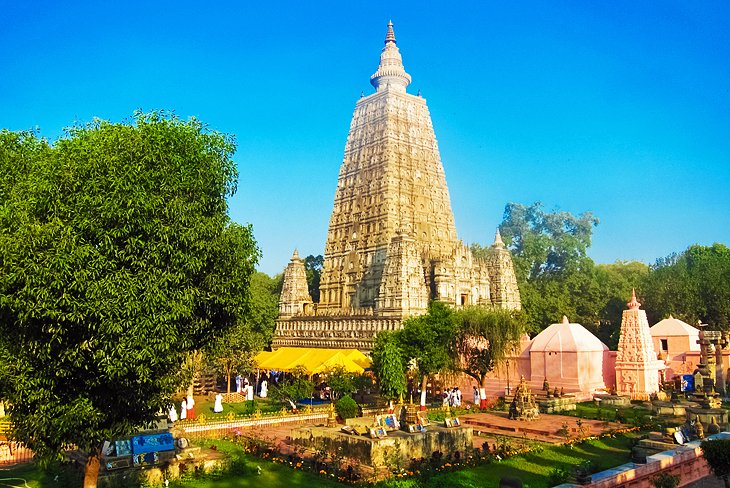
Bodhgaya, considered the world's holiest Buddhist site, attracts thousands of visitors each year, all drawn to participate with the resident monks in meditation and prayer. The focal point of this place of pilgrimage is stunning Mahabodhi Temple, built next to the very spot where Buddha came to Enlightenment and formulated his philosophy on life. Constructed in the 6th century and restored numerous times since, the temple is topped with a beautiful pyramidal spire and houses a large gilded statue of Buddha.
Also of interest is the site's pipal tree, a descendant of the original bodhi tree where Buddha meditated for seven days after the Enlightenment, said to be among the oldest and most venerated trees in the world (you'll know you've found it when you spot the red sandstone slab marking the spot).
Address: Bodhgaya, Bihar 824231
Modern India
Historians consider India's modern age to have begun sometime between 1848 and 1885. The appointment in 1848 of Lord Dalhousie as Governor General of the East India Company set the stage for changes essential to a modern state. These included the consolidation and demarcation of sovereignty, the surveillance of the population, and the education of citizens. Technological changes—among them, railways, canals, and the telegraph—were introduced not long after their introduction in Europe. However, disaffection with the company also grew during this time and set off the Indian Rebellion of 1857. Fed by diverse resentments and perceptions, including invasive British-style social reforms, harsh land taxes, and summary treatment of some rich landowners and princes, the rebellion rocked many regions of northern and central India and shook the foundations of Company rule Although the rebellion was suppressed by 1858, it led to the dissolution of the East India Company and the direct administration of India by the British government. Proclaiming a unitary state and a gradual but limited British-style parliamentary system, the new rulers also protected princes and landed gentry as a feudal safeguard against future unrest.In the decades following, public life gradually emerged all over India, leading eventually to the founding of the Indian National Congress in 1885.
The rush of technology and the commercialisation of agriculture in the second half of the 19th century was marked by economic setbacks and many small farmers became dependent on the whims of far-away markets. There was an increase in the number of large-scale famines, and, despite the risks of infrastructure development borne by Indian taxpayers, little industrial employment was generated for Indians.There were also salutary effects: commercial cropping, especially in the newly canalled Punjab, led to increased food production for internal consumption. The railway network provided critical famine relief, notably reduced the cost of moving goods, and helped nascent Indian-owned industry
After World War I, in which approximately one million Indians served, a new period began. It was marked by British reforms but also repressive legislation, by more strident Indian calls for self-rule, and by the beginnings of a nonviolent movement of non-co-operation, of which Mohandas Karamchand Gandhi would become the leader and enduring symbol. During the 1930s, slow legislative reform was enacted by the British; the Indian National Congress won victories in the resulting elections.The next decade was beset with crises: Indian participation in World War II, the Congress's final push for non-co-operation, and an upsurge of Muslim nationalism. All were capped by the advent of independence in 1947, but tempered by the partition of India into two states: India and Pakistan.
Vital to India's self-image as an independent nation was its constitution, completed in 1950, which put in place a secular and democratic republic.It has remained a democracy with civil liberties, an active Supreme Court, and a largely independent press. Economic liberalisation, which began in the 1990s, has created a large urban middle class, transformed India into one of the world's fastest-growing economies, and increased its geopolitical clout. Indian movies, music, and spiritual teachings play an increasing role in global culture. Yet, India is also shaped by seemingly unyielding poverty, both rural and urban; by religious and caste-related violence; by Maoist-inspired Naxalite insurgencies; and by separatism in Jammu and Kashmir and in Northeast India. It has unresolved territorial disputes with China and with Pakistan. India's sustained democratic freedoms are unique among the world's newer nations; however, in spite of its recent economic successes, freedom from want for its disadvantaged population remains a goal yet to be achieved.
Geography
India accounts for the bulk of the Indian subcontinent, lying atop the Indian tectonic plate, a part of the Indo-Australian Plate. India's defining geological processes began 75 million years ago when the Indian Plate, then part of the southern supercontinent Gondwana, began a north-eastward drift caused by seafloor spreading to its south-west, and later, south and south-east. Simultaneously, the vast Tethyan oceanic crust, to its northeast, began to subduct under the Eurasian Plate. These dual processes, driven by convection in the Earth's mantle, both created the Indian Ocean and caused the Indian continental crust eventually to under-thrust Eurasia and to uplift the Himalayas. Immediately south of the emerging Himalayas, plate movement created a vast trough that rapidly filled with river-borne sediment and now constitutes the Indo-Gangetic Plain. Cut off from the plain by the ancient Aravalli Range lies the Thar Desert.
The original Indian Plate survives as peninsular India, the oldest and geologically most stable part of India. It extends as far north as the Satpura and Vindhya ranges in central India. These parallel chains run from the Arabian Sea coast in Gujarat in the west to the coal-rich Chota Nagpur Plateau in Jharkhand in the east.To the south, the remaining peninsular landmass, the Deccan Plateau, is flanked on the west and east by coastal ranges known as the Western and Eastern Ghats; the plateau contains the country's oldest rock formations, some over one billion years old. Constituted in such fashion, India lies to the north of the equator between 6° 44′ and 35° 30′ north latitude and 68° 7′ and 97° 25′ east longitude.
India's coastline measures 7,517 kilometres (4,700 mi) in length; of this distance, 5,423 kilometres (3,400 mi) belong to peninsular India and 2,094 kilometres (1,300 mi) to the Andaman, Nicobar, and Lakshadweep island chains. According to the Indian naval hydrographic charts, the mainland coastline consists of the following: 43% sandy beaches; 11% rocky shores, including cliffs; and 46% mudflats or marshy shores.
Major Himalayan-origin rivers that substantially flow through India include the Ganges and the Brahmaputra, both of which drain into the Bay of Bengal. Important tributaries of the Ganges include the Yamuna and the Kosi; the latter's extremely low gradient, caused by long-term silt deposition, leads to severe floods and course changes. Major peninsular rivers, whose steeper gradients prevent their waters from flooding, include the Godavari, the Mahanadi, the Kaveri, and the Krishna, which also drain into the Bay of Bengal;and the Narmada and the Tapti, which drain into the Arabian Sea.Coastal features include the marshy Rann of Kutch of western India and the alluvial Sundarbans delta of eastern India; the latter is shared with Bangladesh.India has two archipelagos: the Lakshadweep, coral atolls off India's south-western coast; and the Andaman and Nicobar Islands, a volcanic chain in the Andaman Sea.
The Indian climate is strongly influenced by the Himalayas and the Thar Desert, both of which drive the economically and culturally pivotal summer and winter monsoons.The Himalayas prevent cold Central Asian from blowing in, keeping the bulk of the Indian subcontinent warmer than most locations at similar latitudes The Thar Desert plays a crucial role in attracting the moisture-laden south-west summer monsoon winds that, between June and October, provide the majority of India's rainfall. Four major climatic groupings predominate in India: tropical wet, tropical dry, subtropical humid, and montane.
Temperatures in India have risen by 0.7 °C (1.3 °F) between 1901 and 2018. Climate change in India is often thought to be the cause. The retreat of Himalayan glaciers has adversely affected the flow rate of the major Himalayan rivers, including the and the Brahmaputra. According to some current projections, the number and severity of droughts in India will have markedly increased by the end of the present century.
Biodiversity
India is a megadiverse country, a term employed for 17 countries which display high biological diversity and contain many species exclusively indigenous, or endemic, to them.[186] India is a habitat for 8.6% of all mammal species, 13.7% of bird species, 7.9% of reptile species, 6% of amphibian species, 12.2% of fish species, and 6.0% of all flowering plant species.[187][188] Fully a third of Indian plant species are endemic.[189] India also contains four of the world's 34 biodiversity hotspots,[58] or regions that display significant habitat loss in the presence of high endemism.[j][190]
India's forest cover is 99,278 km2 (38,331 sq mi), which is 21.67% of the country's total land area.[59] It can be subdivided further into broad categories of canopy density, or the proportion of the area of a forest covered by its tree canopy.[191] Very dense forest, whose canopy density is greater than 70%, occupies 3.02% of India's land area.[191][59] It predominates in the tropical moist forest of the Andaman Islands, the Western Ghats, and Northeast India.[192] Moderately dense forest, whose canopy density is between 40% and 70%, occupies 9.39% of India's land area.[191][59] It predominates in the temperate coniferous forest of the Himalayas, the moist deciduous sal forest of eastern India, and the dry deciduous teak forest of central and southern India.Open forest, whose canopy density is between 10% and 40%, occupies 9.26% of India's land area, and predominates in the babul-dominated thorn forest of the central Deccan Plateau and the western Gangetic plain.[
Among the Indian subcontinent's notable indigenous trees are the astringent Azadirachta indica, or neem, which is widely used in rural Indian herbal medicine, and the luxuriant Ficus religiosa, or peepul, which is displayed on the ancient seals of Mohenjo-daro, and under which the Buddha is recorded in the Pali canon to have sought enlightenment.

Many Indian species have descended from those of Gondwana, the southern supercontinent from which India separated more than 100 million years ago. India's subsequent collision with Eurasia set off a mass exchange of species. However, volcanism and climatic changes later caused the extinction of many endemic Indian forms. Still later, mammals entered India from Asia through two zoogeographical passes flanking the Himalayas.This had the effect of lowering endemism among India's mammals, which stands at 12.6%, contrasting with 45.8% among reptiles and 55.8% among amphibians. Notable endemics are the vulnerable hooded leaf monkey and the threatened Beddom's toad[ of the Western Ghats.
India contains 172 IUCN-designated threatened animal species, or 2.9% of endangered forms. These include the endangered Bengal tiger and the Ganges river dolphin. Critically endangered species include: the gharial, a crocodilian; the great Indian bustard; and the Indian white-rumped vulture, which has become nearly extinct by having ingested the carrion of diclofenac-treated cattle.The pervasive and ecologically devastating human encroachment of recent decades has critically endangered Indian wildlife. In response, the system of national parks and protected areas, first established in 1935, was expanded substantially. In 1972, India enacted the Wildlife Protection Act and Project Tiger to safeguard crucial wilderness; the Forest Conservation Act was enacted in 1980 and amendments added in 1988.India hosts more than five hundred wildlife sanctuaries and thirteen biosphere reserves,four of which are part of the World Network of Biosphere Reserves; twenty-five wetlands are registered under the Ramsar Convention.
Government
India is a federation with a parliamentary system governed under the Constitution of India—the country's supreme legal document. It is a constitutional republic and representative democracy, in which "majority rule is tempered by minority rights protected by law". Federalism in India defines the power distribution between the union and the states. The Constitution of India, which came into effect on 26 January 1950,originally stated India to be a "sovereign, democratic republic;" this characterisation was amended in 1971 to "a sovereign, socialist, secular, democratic republic". India's form of government, traditionally described as "quasi-federal" with a strong centre and weak states,has grown increasingly federal since the late 1990s as a result of political, economic, and social changes.
| Flag | Tiranga (Tricolour) |
|---|---|
| Emblem | Sarnath Lion Capital |
| Anthem | Jana Gana Mana |
| Song | "Vande Mataram" |
| Language | None |
| Currency | ₹ (Indian rupee) |
| Calendar | Saka |
| Animal |
|
| Flower | Lotus |
| Fruit | Mango |
| Tree | Banyan |
| River | Ganges |
The Government of India comprises three branches:
- Executive: The President of India is the ceremonial head of state, who is elected indirectly for a five-year term by an electoral college comprising members of national and state legislatures.The Prime Minister of India is the head of government and exercises most executive power. Appointed by the president, the prime minister is by convention supported by the party or political alliance having a majority of seats in the lower house of parliament. The executive of the Indian government consists of the president, the vice president, and the Union Council of Ministers—with the cabinet being its executive committee—headed by the prime minister. Any minister holding a portfolio must be a member of one of the houses of parliament. In the Indian parliamentary system, the executive is subordinate to the legislature; the prime minister and their council are directly responsible to the lower house of the parliament. Civil servants act as permanent executives and all decisions of the executive are implemented by them.
- Legislature: The legislature of India is the bicameral parliament. Operating under a Westminster-style parliamentary system, it comprises an upper house called the Rajya Sabha (Council of States) and a lower house called the Lok Sabha (House of the People). The Rajya Sabha is a permanent body of 245 members who serve staggered six-year terms. Most are elected indirectly by the state and union territorial legislatures in numbers proportional to their state's share of the national population. All but two of the Lok Sabha's 545 members are elected directly by popular vote; they represent single-member constituencies for five-year terms. Two seats of parliament, reserved for Anglo-Indian in the article 331, have been scrapped
- Judiciary: India has a three-tier unitary independent judiciary comprising the supreme court, headed by the Chief Justice of India, 25 high courts, and a large number of trial courts. The supreme court has original jurisdiction over cases involving fundamental rights and over disputes between states and the centre and has appellate jurisdiction over the high courts. It has the power to both strike down union or state laws which contravene the constitution, and invalidate any government action it deems unconstitutional.




